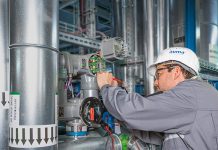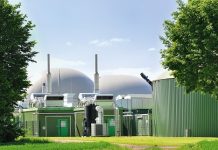Market Drayton Sewage Treatment Works serves a population of 18,400 and discharges into the river Tern, a breeding ground for Brown Trout. Market Drayton STW had a UT failure and 8 action limit breaches for ammonia and BOD in 2010 and was the tenth most vulnerable works in Severn Trent’s West region.
The problem
The performance of the oxidation ditches and final settlement tanks was being affected by mixer and blower failures. These problems were exacerbated by diffuser blinding and blockage of Final Settlement Tank bell mouths. Due to these issues, there was poor Dissolved Oxygen control in the ditches resulting in filamentous bacteria growth and associated solids in the final effluent leading to compliance risks.
Market Drayton STW also has a 2mg/l Phosphorus consent which is met by chemical dosing. The Ferric dosing rate was double the template standard and this attributed to poor mixing in the oxidation ditches. It was believed that the P limit could be met through Biological nutrient removal if the aeration and mixing were working as designed. BNR – Biological Nutrient Removal – a process used for nitrogen and phosphorus removal from wastewater before it is discharged into surface or ground water – was occurring in the ditches prior to the above issues arising.
To maintain dissolved oxygen levels, a hired blower and generator have been deployed with an annual cost of £162,000 in hire and fuel costs. Furthermore, local neighbours had complained due to the noise from the constant running of the generator. The power required by the existing mixers and blower was also very close to exceeding the available power to the works, creating further risks.
The solution
The main contractor JN Bentley asked Suprafilt – specialists in the design, installation and commissioning of both fixed and lift-out fine-bubble diffused aeration systems for municipal and industrial sewage treatment plants, to come up with a solution. Upon evaluation it was clear that the existing mixers and aeration system were not designed to work together and were “fighting against each other”. This was resulting in poor treatment and wasting of power. Suprafilt took an holistic approach and selected appropriate mixers and aeration diffusers and produced a computational fluid dynamics analysis to model the process and ensure that both mixers and aeration were designed to work together. This resulted in huge savings in power, optimised treatment and elimination of the power and consent risks whilst improving operability, treatment and Phosphorous removal.
The Suprafilt 9” diameter membrane disc diffusers not only increased oxygen transfer efficiency but also had Teflon PTFE coating to prevent the blinding of diffusers. Wilo mixers were selected to not only give high efficiency and reliability, but were also fitted with back curved blades to eliminate rag build-up. The speed of the blades was also optimised to give the required tank velocity when working with the aeration system and not against it.
The Wilo mixers are Wilo-EMU TR316.77-4/16 – two per ditch. They are slow running submersible mixers reduced by a two-stage planetary gear. They provide energetically optimized mixing and circulation of activated sludges and the generation of flow rates in circulation channels. The planetary gear enables transmission of high torque to the propeller with an aerodynamic design. It features a replaceable planetary gear for adjusting the propeller speed and comes with a self-cleaning propeller with backward-curved blades to avoid tressing.
The first feedback following the new installations has been extremely positive. This shows a typically 45% reduction in energy usage following the installation. At 10p/kw this equates to an annual saving of £68,975 and provides a return on investment in 2.4 years.
A highly successful outcome courtesy of Superafilt and Wilo – converting a problem into an opportunity, courtesy of the project team on the job.





